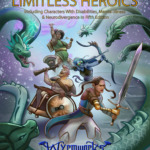Atypical Toes

The shape of your toes is outside the range of those typically expected for your ancestry. Choose or roll on the following table. This trait is typically permanent.
The traits in this book were designed primarily based on humans, so some traits may not make sense for characters of other ancestries. Talons on an avian would be expected, but hooves would not, whereas hooves on a minotaur or tiefling are typical. Polydactyly on a satyr might mean having feet like a human. By exploring fantasy combinations, we gain insight into real-world experiences of having an atypical mind or body.
| d20 | Toe Difference |
|---|---|
| 1–3 | Atypically-shaped |
| 4–10 | Missing toes |
| 11–12 | Overgrowth |
| 13–14 | Polydactyly |
| 15–16 | Syndactyly |
| 17 | Talons |
| 18–19 | Undergrowth |
| 20 | Webbed |
- Atypically shaped. 1d10 of your toes bend in odd directions, curving sideways or even backwards. (Roll 1d10 for the number of toes, then 1d10 for each to determine which toe.) Depending how many toes are atypically shaped from each foot, you have penalties to Dexterity ability checks and saving throws requiring balance equal to −1 per (number of atypically shaped toes) ÷2.
- Missing Toes. You are missing 1d10 toes. (Roll 1d10 for the number of toes, then 1d10 for each to determine which toe.) Depending how many toes are missing from each foot, you have penalties to Dexterity ability checks and saving throws requiring balance equal to −1 per (number of missing toes) ÷2.
- Overgrowth. 1d10 of your toes are longer than expected for your ancestry. This has no immediate game mechanic but will lead to confusion, fear, or other social effects, depending on the situation. Boots and other footwear need to be custom made and cost 50−100 percent more than usual.
- Polydactyly. You have (IE) extra toes on your foot (/feet). This has no immediate game mechanic but will lead to confusion, fear, or other social effects, depending on the situation. Boots and other footwear need to be custom made and cost 50−100 percent more than usual.
- Syndactyly. 1 + (IE) of your toes are fused together. Depending how many toes are fused, you have penalties to Dexterity ability checks and saving throws requiring balance equal to −1 per (number of fused toes) ÷2.
- Talons. Your toes end in claws or talons. This allows you to make an unarmed strength attack that does 2 (1d4) slashing damage if barefoot. Boots and other footwear need to be custom made and cost 50−100 percent more than usual.
- Undergrowth. 1d10 of your toes are smaller and weaker than expected. (Roll 1d10 for the number of toes, then 1d10 for each to determine which toe.) Depending how many toes are undergrown from each foot, you have penalties to Dexterity ability checks and saving throws requiring balance equal to −1 per (number of undergrown toes) ÷2.
- Webbed. Your toes are webbed and give you +5 feet on your swimming speed. Boots and other footwear need to be custom made and cost 50−100 percent more than usual.
In the real world, human webbed digits do not give swimmers any noticeable benefits.
Real-world Examples
Hammer Toe, Anvil Toe, Curly Toe, Claw Toe, Adductovarus Toe, Syndactyly, Polydactyly, Arthritis
Assistive Options
As described in the above listings, custom boots are necessary for many of these but do not change game mechanics.
Magical Assistance
Boots of Striding and Springing can assist with Dexterity penalties relative to malformed toes at the expense of the jumping benefit.